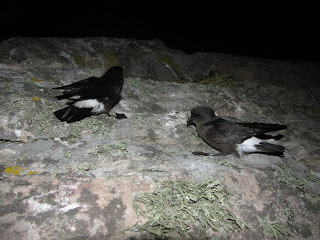Alderney is the third largest Channel Island (after Jersey
and Guernsey) and is the closest one to the French coast. I started working with
the Alderney Wildlife Trust in
March 2013, initially on a one year placement that extended to 21 months due to
how much I enjoyed it there.
 |
| Bottlenose dolphins off the bow of our tour boat |
As the seabird ecologist (retitled Ramsar ecologist in 2014)
it was my role to fulfil the ongoing management plan for Alderney’s Ramsar
site. This role included so many aspects, from boat crewing and PhD student
assistance to primary school education and media work. But it was the
monitoring of multiple seabird species where most of my work was focused.
 |
| A view from within the gannet colony of Les Etacs |
The logistics of monitoring multiple colonies on numerous
offshore islets with limitations to personnel availability and sea/weather conditions is not easy,
especially when considering the boat being used also had to be used as a tour
boat for visitors. But the experience it gave me was ideal preparation for a
job on Bird Island where numerous work streams will have to be well balanced to
get the best data available.
 |
| Fulmar incubating an egg |
I worked with numerous species on Alderney, including
puffin, gannet, fulmar, ringed plover, common tern and shag (although
unfortunately the razorbills were in a location that was impossible to monitor,
much to my disappointment!). But there were a few work streams in particular
that stood out for me in my time on Alderney:
LIVE
 |
| Views of puffins from Alderney's live camera (note the puffling just out the burrow in the middle of the third shot) |
Alderney has live web cameras on their gannet and puffin colonies during the breeding season. These cameras and the ecological work
around the species’ is the main factor constituting an educational program
available to primary schools across the UK. This program, LIVE: Teaching Through Nature, was an amazing way to be
able to show the wonders of nature to the next generation and hopefully inspire
the next group of wildlife conservationists.
Lesser black-backed gulls
 |
| Lesser black-backed gulls |
OK, let’s get this out the way first…. there is no such
thing as a seagull!! Many species of gull live in the UK, the most commonly
sighted one in coastal towns is the herring gull, whilst my personal favourite
is the lesser black-backed gull. I spent a long time monitoring this species
around Alderney, working with the Channel Island Bird Ringers to study them
closely. Their foraging and migratory habits were fascinating aspects of their
ecology and their breeding success has been very hit and miss in recent years.
Finding out more about this species is something I am still getting involved in
today.
Storm-petrel
 |
| Not as big as an albatross but just as impressive! |
Storm-petrels are within the same family as larger petrels
and albatross, but the European storm-petrel is just the size of a sparrow. As
such, to avoid predators they only come to land at night to feed their chick whilst they spend the
day far out to sea foraging for food on the water’s surface. As most seabird
ecologists will attest to when you have these birds close-up they have a very
unique and amazing smell! To get close-up to them we undertook ringing studies
that have allowed population estimates that are more reliable and higher than
any previously done around Alderney.
But most importantly to me I started dating my girlfriend, Nicci, during a storm-petrel survey in July 2014, so they will always be a special species.
But most importantly to me I started dating my girlfriend, Nicci, during a storm-petrel survey in July 2014, so they will always be a special species.
 |
| Nicci looking out for seabirds around a gannet colony on Les Etacs |
This blog is nowhere near in depth enough to fully describe
how important Alderney was for my personal and professional development.
Without my time there I would not have been ready for the job with BAS and I
would recommend it to anyone looking at getting in to a similar career; so for
more details on the Ramsar work in Alderney click here.
 |
| Sunset behind the Sister Rocks |
No comments:
Post a Comment